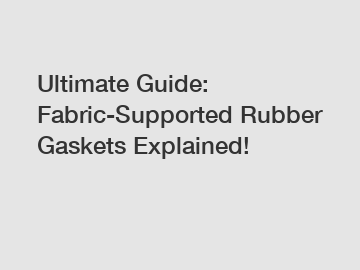Ultimate Guide: Fabric-Supported Rubber Gaskets Explained!
When it comes to industrial applications that require sealing solutions, rubber gaskets play a crucial role in ensuring leak-proof and reliable performance. There are various types of rubber gaskets available on the market, each designed to meet specific requirements and standards. One of the most popular and versatile types of rubber gaskets is fabric-supported rubber gaskets, which offer a unique combination of flexibility, strength, and durability.
In this ultimate guide, we will delve into the world of fabric-supported rubber gaskets, exploring their composition, benefits, applications, and best practices for installation and maintenance. Whether you're a seasoned engineer or a novice DIY enthusiast, this guide will provide you with all the information you need to make informed decisions when it comes to selecting and using fabric-supported rubber gaskets.
Composition of Fabric-Supported Rubber Gaskets:

Fabric-supported rubber gaskets are commonly made from a blend of rubber compounds and reinforcing fabrics, such as polyester, aramid, or fiberglass. The fabric serves to enhance the gasket's strength, flexibility, and resistance to tearing, making it ideal for applications that require a high degree of performance under varying conditions.
The rubber compounds used in fabric-supported rubber gaskets can vary depending on the specific requirements of the application. Common rubber materials include neoprene, EPDM, silicone, and nitrile, each offering unique properties such as resistance to temperature, chemicals, oils, and weathering.
Benefits of Fabric-Supported Rubber Gaskets:
Fabric-supported rubber gaskets offer a range of benefits that make them an ideal choice for a wide variety of applications. Some of the key advantages of fabric-supported rubber gaskets include:
1. Enhanced Strength: The fabric reinforcement in fabric-supported rubber gaskets provides added strength and resistance to tearing, making them suitable for high-pressure and high-temperature applications.
2. Flexibility: Fabric-supported rubber gaskets are highly flexible, allowing for easy installation and conforming to uneven surfaces for a tight seal.
3. Durability: The combination of rubber and fabric materials in fabric-supported rubber gaskets results in a durable and long-lasting sealing solution that can withstand harsh environmental conditions.
4. Versatility: Fabric-supported rubber gaskets are available in a range of sizes, shapes, and materials, making them suitable for a wide variety of industrial applications.
Applications of Fabric-Supported Rubber Gaskets:
Fabric-supported rubber gaskets are used in a wide range of industries and applications, thanks to their versatile and reliable performance. Some common applications of fabric-supported rubber gaskets include:
1. Automotive: Fabric-supported rubber gaskets are used in automotive engines, transmissions, and fuel systems to provide leak-proof seals and prevent the ingress of contaminants.
2. Aerospace: Fabric-supported rubber gaskets are employed in aircraft engines, hydraulic systems, and avionics to ensure reliable performance under extreme temperatures and pressures.
3. Marine: Fabric-supported rubber gaskets are utilized in marine engines, pumps, and valves to prevent water ingress and maintain operational efficiency in challenging marine environments.
4. Industrial: Fabric-supported rubber gaskets find applications in industrial machinery, HVAC systems, and process equipment to provide sealing solutions for a wide variety of industrial processes.
Best Practices for Installation and Maintenance:
To ensure the optimal performance and longevity of fabric-supported rubber gaskets, it is important to follow best practices for installation and maintenance. Some key tips for installing and maintaining fabric-supported rubber gaskets include:
1. Proper Surface Preparation: Before installing a fabric-supported rubber gasket, ensure that the mating surfaces are clean, smooth, and free from any defects that could compromise the seal.
2. Correct Torque: When tightening bolts or screws that secure the gasket in place, be sure to apply the correct torque to avoid over-compression or under-compression of the gasket.
3. Regular Inspection: Periodically inspect fabric-supported rubber gaskets for signs of wear, damage, or degradation, and replace them as needed to prevent leaks and ensure optimal performance.
4. Use Compatible Sealing Lubricants: When installing fabric-supported rubber gaskets, use compatible sealing lubricants to facilitate proper compression and sealing of the gasket.
In conclusion, fabric-supported rubber gaskets are a versatile and reliable sealing solution that offers a unique combination of strength, flexibility, and durability. By understanding their composition, benefits, applications, and best practices for installation and maintenance, you can make informed decisions when selecting and using fabric-supported rubber gaskets for your industrial needs. Whether you're sealing automotive engines, aerospace systems, marine equipment, or industrial machinery, fabric-supported rubber gaskets are sure to provide leak-proof and reliable performance for a wide range of applications.
For more wholesale o ring factories, colored rubber o rings catalog, bakelite handle gripinformation, please contact us. We will provide professional answers.
40
0
0

Comments
All Comments (0)